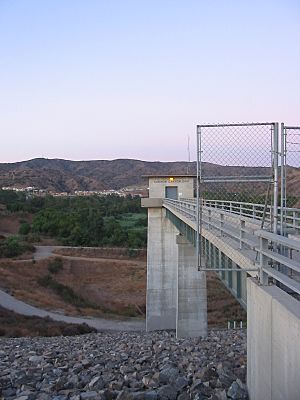Carbon Canyon Dam facts for kids
Quick facts for kids Carbon Canyon Dam |
|
|---|---|
| Country | United States |
| Location | Orange County, California |
| Coordinates | 33°54′49″N 117°50′21″W / 33.91361°N 117.83917°W |
| Construction began | 1959 |
| Opening date | 1961 |
| Owner(s) | |
| Dam and spillways | |
| Type of dam | Earth |
| Impounds | Carbon Canyon Creek |
| Height | 99 feet (30 m) |
| Length | 2,610 feet (800 m) |
| Dam volume | 1,500,000 cubic yards (1,100,000 m3) |
| Reservoir | |
| Creates | Carbon Canyon Reservoir |
| Total capacity | 7,033 acre-feet (8,675,000 m3) |
| Catchment area | 19.3 square miles (50 km2) |
| Surface area | 221 acres (89 ha) |
Carbon Canyon Dam, also known as Carbon Creek Dam, is a large structure located in Orange County, California. It sits about 4 miles (6.4 km) east of Brea and 12 miles (19 km) north of Santa Ana. The main job of this dam is to help control floods.
The dam holds back water from Carbon Canyon Creek. This creek flows from the Puente and Chino Hills towards the coast. Eventually, its water joins Coyote Creek and then flows into the San Gabriel River.
Contents
Why Was the Dam Built?
Carbon Canyon Dam was built mainly to protect communities from floods. Before the dam, heavy rains could cause the Carbon Canyon Creek to overflow. This would flood homes and businesses in Orange County.
The idea for the dam came from the Orange County Flood Control District. They wanted a way to manage the water and keep people safe. The U.S. Congress approved the project in the 1930s. This approval allowed the government to buy the land needed for the dam and its reservoir.
How the Dam Was Planned and Built
Planning the Dam
Engineers and planners worked for many years to design Carbon Canyon Dam. The U.S. Army Corps of Engineers, Los Angeles District, played a big role. They created detailed plans for the dam, its outlet works, and a special channel.
Their plans also included moving roads, bridges, and even some buildings. This was to make sure the area was clear for the dam's construction.
Building the Dam
Construction of Carbon Canyon Dam began in April 1959. It took about two years to build. The U.S. Army Corps of Engineers officially accepted the completed dam in May 1961.
The Oberg Construction Company from Northridge, California was in charge of building the dam.
How Carbon Canyon Dam Works
The dam creates a reservoir called Carbon Canyon Reservoir. When there's a lot of rain, the dam holds back the extra water. This stops the creek from flooding downstream areas.
The dam is part of a larger system that manages water in the area. Downstream from the dam, there are several other basins. These include Miller, Placentia, Raymond, and Gilbert basins. Their main purpose is to slow down floodwaters even more.
Water Diversion
At a place called Miller Basin, the water from Carbon Canyon Creek can be split.
- Some water can go into the Carbon Canyon Diversion Channel. This channel sends water towards the Santa Ana River.
- Other water can go into the Carbon Creek Channel. This channel flows west towards Coyote Creek and then to the San Gabriel River.
This system allows water managers to control where the floodwaters go. It helps protect different communities from flooding.
See also
- Floodgate
- List of reservoirs and dams in California
- List of lakes in California
- List of largest dams
- Rivers of California
- List of rivers of California
Images for kids



